Study of Operation of the Thermoelectric Generators Dedicated to Wood-Fired Stoves
Abstract
1. Introduction
- Heat exchanger, which absorbs the heat generated in the stove (directly from the furnace or from the chimney) and transfers it into the thermoelectric modules;
- Thermoelectric modules (TEMs), which generate electricity when a temperature difference exists between their ends;
- Heat sink dedicated to dissipating the heat from the thermoelectric modules.
- TEG No. 1—air-cooled unit with a matched power of 45 We (designed for mounting on a flat hot surface);
- TEG No. 2—water-cooled unit with a matched power of 100 We (designed for mounting on a flat hot surface);
- TEG No. 3—water-cooled unit with a matched power of 350 We (designed for mounting on a flue gas channel).
2. Materials and Methods
2.1. Configuration of the Experimental Rig
- The wood-fired steel stove possessed efficiency at a level of 81% and nominal heating capacity at a level of 12 kWt (during typical operation, this power ranges from 8 to 16 kWt). In the presented investigations, pinewood with a moisture content of 12–13% and a lower heating value (LHV) of approximately 4.4 kWh/kg was burned. The initial fuel input ranged from 4.0 to 6.0 kg depending on the measurement series. Then, additional wood inputs were added during the combustion process. The view of the tested wood-fired stove is shown in Figure 5.
- Dedicated constructions of the thermoelectric generator provided for installation on the chimney were used (two versions were analyzed: The first one was equipped with one Bi2Te3 TEM characterized by a matched power of 10.5 We and operated with a temperature difference of 150 K. The second one had four low-cost Bi2Te3 TEMs characterized by a total matched power of 28.8 We and operated with a temperature difference of 250 K).
- Dedicated control and measurement systems equipped with the following:
- ○
- WAGO PLC controller with a set of I/O modules, including analog inputs and outputs (4–20 mA, 0–10 V, Pt100, PTTK) and digital inputs and outputs (0/24 V);
- ○
- Thermocouple and resistance sensors provided for monitoring the temperature of flue gas inside the combustion chamber (tfg1), flue gas in the flue gas channel (at the inlet of the thermoelectric generator—tfg2; and the outlet from the thermoelectric generator—tfg3), air flown to the combustion chamber (tair), and cooling water temperature (at the inlet of the thermoelectric generator—twat1; and the outlet from the thermoelectric generator—twat2);
- ○
- Thermo-anemometer provided to measure the speed of air blowing into the combustion chamber with a measurement range of 0–2 m/s;
- ○
- Throttle with servomechanism controlled via analog 0–10 V signal to control the amount of air flowing to the combustion chamber;
- ○
- Water flowmeter to measure cooling water flow (mwat);
- ○
- PC with installed CoDeSys software.
2.2. The Initial Version of the Developed Thermoelectric Generator (TEG No. 4)
2.3. The Prototype of the Developed Thermoelectric Generator (TEG No. 5)
2.4. Comparative Power Coefficient and Comparative Power-to-Temperature Coefficient
2.5. Economic Analysis of the Operation of mCHP System
3. Results
3.1. Results of the Tests of the Operation Parameters of TEG No. 4
3.1.1. Variations in the Temperature of the Flue Gas, Hot Surface, and Cooling Water
3.1.2. Variations in the Temperature of the Flue Gas, Hot Surface, and Cooling Water
3.1.3. The Operating Characteristics of the Tested TEG No. 4
3.2. Results of the Tests of the Operation Parameters of the TEG No. 5
3.2.1. Variations in the Temperature of the Flue Gas, Hot Surface, and Cooling Water
3.2.2. The Operational Characteristics of TEG No. 5
3.3. Analysis of the Results Obtained during the Tests
3.3.1. Variations in Voltage as a Function of Temperature
3.3.2. Variations in Generated Power as a Function of Temperature
3.3.3. Comparative Power Coefficient and Comparative Power to Temperature Coefficient
3.3.4. The Economical Aspects of the Operation of the Stove with TEG
4. Conclusions
Funding
Acknowledgments
Conflicts of Interest
Nomenclature
| CHP | Combined Heat and Power |
| CO2 | Carbon Dioxide |
| CPC | Comparative Power Coefficient |
| CPTC | Comparative Power to Temperature Coefficient |
| LED | Lighting Emitting Diode |
| LHV | Lower Heating Value |
| mCHP | Microscale Combined Heat and Power |
| NPV | Net Present Value |
| SPBT | Simple Payback Time |
| TEG | Thermoelectric Generator |
| TEM | Thermoelectric Module |
| WFS | Wood-fired Stove |
References
- Noonan, C.W.; Semmens, E.O.; Ware, D.; Smith, P.; Boyer, B.B.; Erdei, E.; Hopkins, S.E.; Lewis, J.; Ward, T.J. Wood stove interventions and child respiratory infections in rural communities: KidsAir rationale and methods. Contemp. Clin. Trials 2020, 89, 105909. [Google Scholar] [CrossRef]
- Kryzia, D.; Kuta, M.; Matuszewska, D.; Olczak, P. Analysis of the Potential for Gas Micro-Cogeneration Development in Poland Using the Monte Carlo Method. Energies 2020, 13, 3140. [Google Scholar] [CrossRef]
- Zoui, M.A.; Bentouba, S.; Stocholm, J.G.; Bourouis, M. A Review on Thermoelectric Generators: Progress and Applications. Energies 2020, 13, 3606. [Google Scholar] [CrossRef]
- Gelbstein, Y.; Davidow, J.; Leshem, E.; Pinshow, O.; Moisa, S. Significant lattice thermal conductivity reduction following phase separation of the highly efficient GexPb1–xTe thermoelectric alloys. Phys. Status Solidi 2014, 251, 1431–1437. [Google Scholar] [CrossRef]
- Ben-Ayoun, D.; Sadia, Y.; Gelbstein, Y. High temperature thermoelectric properties evolution of Pb1-xSnxTe based alloys. J. Alloys Compd. 2017, 722, 33–38. [Google Scholar] [CrossRef]
- Xing, Y.; Liu, R.; Liao, J.; Zhang, Q.; Xia, X.; Wang, C.; Huang, H.; Chu, J.; Gu, M.; Zhu, T.; et al. High-efficiency half-Heusler thermoelectric modules enabled by self-propagating synthesis and topologic structure optimization. Energy Environ. Sci. 2019, 12, 3390–3399. [Google Scholar] [CrossRef]
- Rull-Bravo, M.; Moure, A.; Fernández, J.F.; Martín-González, M. Skutterudites as thermoelectric materials: Revisited. RSC Adv. 2015, 5, 41653–41667. [Google Scholar] [CrossRef]
- Riffat, S.B.; Ma, X. Thermoelectrics: A review of present and potential applications. Appl. Therm. Eng. 2003, 23, 913–935. [Google Scholar] [CrossRef]
- Lertsatitthanakorn, C. Electrical performance analysis and economic evaluation of combined biomass cook stove thermoelectric (BITE) generator. Bioresour. Technol. 2007, 98, 1670–1674. [Google Scholar] [CrossRef]
- Najjar, Y.S.H.; Kseibi, M.M. Thermoelectric stoves for poor deprived regions—A review. Renew. Sustain. Energy Rev. 2017, 80, 597–602. [Google Scholar] [CrossRef]
- World Energy Outlook—Topics—IEA. Available online: https://www.iea.org/topics/world-energy-outlook (accessed on 31 August 2021).
- Szramowiat-Sala, K.; Korzeniewska, A.; Sornek, K.; Marczak, M.; Wierońska, F.; Berent, K.; Gołaś, J.; Filipowicz, M. The properties of particulate matter generated during wood combustion in in-use stoves. Fuel 2019, 253, 792–801. [Google Scholar] [CrossRef]
- Sornek, K. Prototypical Biomass-Fired Micro-Cogeneration Systems—Energy and Ecological Analysis. Energies 2020, 13, 3909. [Google Scholar] [CrossRef]
- Mal, R.; Prasad, R.; Vijay, V.K.; Verma, A.R. The design, development and performance evaluation of thermoelectric generator (TEG) integrated forced draft biomass cookstove. Procedia Comput. Sci. 2015, 52, 723–729. [Google Scholar] [CrossRef]
- Champier, D.; Bédécarrats, J.P.; Kousksou, T.; Rivaletto, M.; Strub, F.; Pignolet, P. Study of a TE (thermoelectric) generator incorporated in a multifunction wood stove. Energy 2011, 36, 1518–1526. [Google Scholar] [CrossRef]
- Mastbergen, D.; Willson, B.; Joshi, S. Producing Light from Stoves using a Thermoelectric Generator. Ethos 2005, 2005, 15–27. [Google Scholar]
- Patowary, R.; Baruah, D.C. Feasibility study of TEG-integrated biomass cook stove for electrical power generation specific to rural areas with inadequate electricity. Energy Sour. Part A Recov. Utilizat. Environ. Effects 2019. [Google Scholar] [CrossRef]
- Lv, H.; Li, G.; Zheng, Y.; Hu, J.; Li, J. Compact Water-Cooled Thermoelectric Generator (TEG) Based on a Portable Gas Stove. Energies 2018, 11, 2231. [Google Scholar] [CrossRef]
- Montecucco, A.; Siviter, J.; Knox, A.R. A Combined Heat and Power System for Solid-fuel Stoves Using Thermoelectric Generators. Energy Procedia 2015, 75, 597–602. [Google Scholar] [CrossRef]
- Liu, C.; Chen, P.; Li, K. A 500 W low-temperature thermoelectric generator: Design and experimental study. Int. J. Hydrog. Energy 2014, 39, 15497–15505. [Google Scholar] [CrossRef]
- O’Shaughnessy, S.M.; Deasy, M.J.; Doyle, J.V.; Robinson, A.J. Field trial testing of an electricity-producing portable biomass cooking stove in rural Malawi. Energy Sustain. Dev. 2014, 20, 1–10. [Google Scholar] [CrossRef]
- Favarel, C.; Champier, D.; Rozis, J.F.; Kousksou, T.; Bédécarrats, J.P. Thermoelectricity—A promising complementarity with efficient stoves in off-grid-areas. J. Sustain. Dev. Energy Water Environ. Syst. 2015, 3, 256–268. [Google Scholar] [CrossRef]
- Goudarzi, A.M.; Mazandarani, P.; Panahi, R.; Behsaz, H.; Rezania, A.; Rosendahl, L.A. Integration of Thermoelectric Generators and Wood Stove to Produce Heat, Hot Water, and Electrical Power. J. Electron. Mater. 2013, 42, 2127–2133. [Google Scholar] [CrossRef]
- Araiz, M.; Casi, Á.; Catalán, L.; Martínez, Á.; Astrain, D. Prospects of waste-heat recovery from a real industry using thermoelectric generators: Economic and power output analysis. Energy Convers. Manag. 2020, 205, 112376. [Google Scholar] [CrossRef]
- Borsukiewicz-Gozdur, A.; Wiśniewski, S.; Mocarski, S.; Bańkowski, M. ORC power plant for electricity production from forest and agriculture biomass. Energy Convers. Manag. 2014, 87, 1180–1185. [Google Scholar] [CrossRef]
- Sornek, K.; Filipowicz, M. A study of the applicability of a straw-fired batch boiler as a heat source for a small-scale cogeneration unit. Chem. Process Eng. Inz. Chem. Process. 2016, 37, 503–515. [Google Scholar] [CrossRef][Green Version]
- Żołądek, M.; Figaj, R.; Sornek, K. Energy analysis of a micro-scale biomass cogeneration system. Energy Convers. Manag. 2021, 236, 114079. [Google Scholar] [CrossRef]
- Sornek, K.; Filipowicz, M.; Żołądek, M.; Kot, R.; Mikrut, M. Comparative analysis of selected thermoelectric generators operating with wood-fired stove. Energy 2019, 166, 1303–1313. [Google Scholar] [CrossRef]
- Available online: https://www.grundfos.com/us (accessed on 21 September 2021).
- Vogel, M. Heating with Wood: Principles or Combustion; Montana State University Extension: Bozeman, MT, USA, 2005. [Google Scholar]
- Sornek, K.; Filipowicz, M.; Rzepka, K. Study of clean combustion of wood in a stove-fireplace with accumulation. J. Energy Inst. 2017, 90, 613–623. [Google Scholar] [CrossRef]
- Eurostat Data. Available online: https://ec.europa.eu (accessed on 21 September 2021).

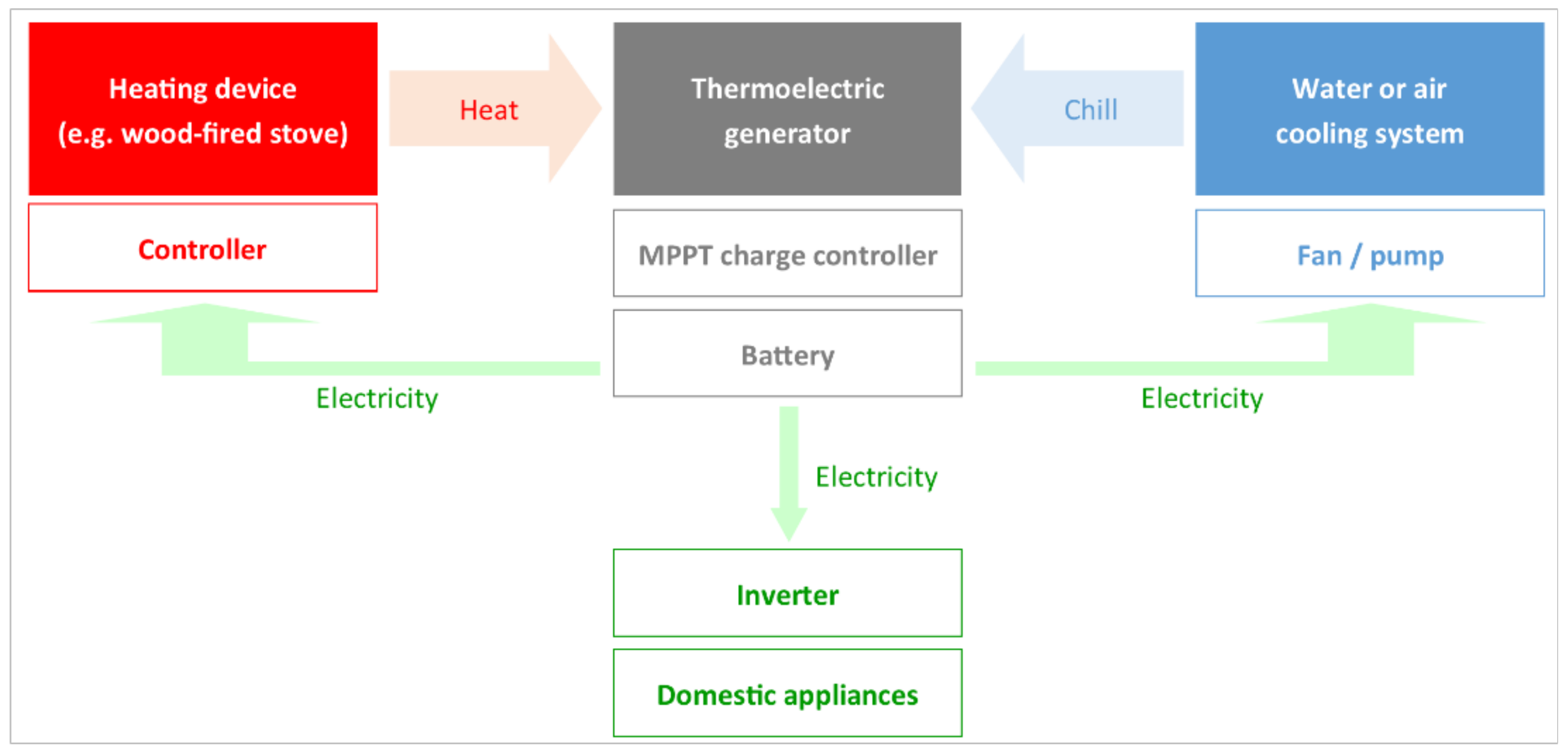

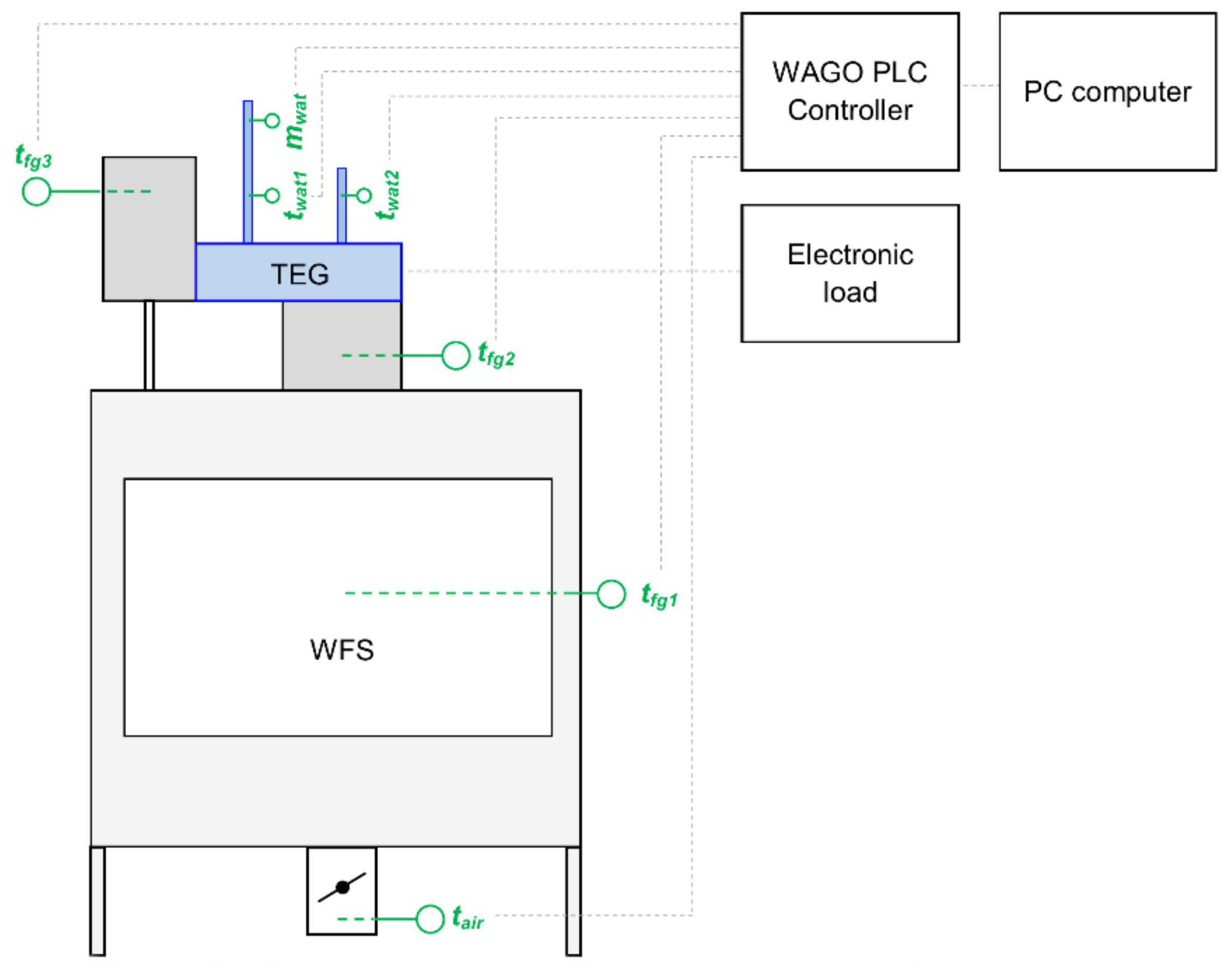


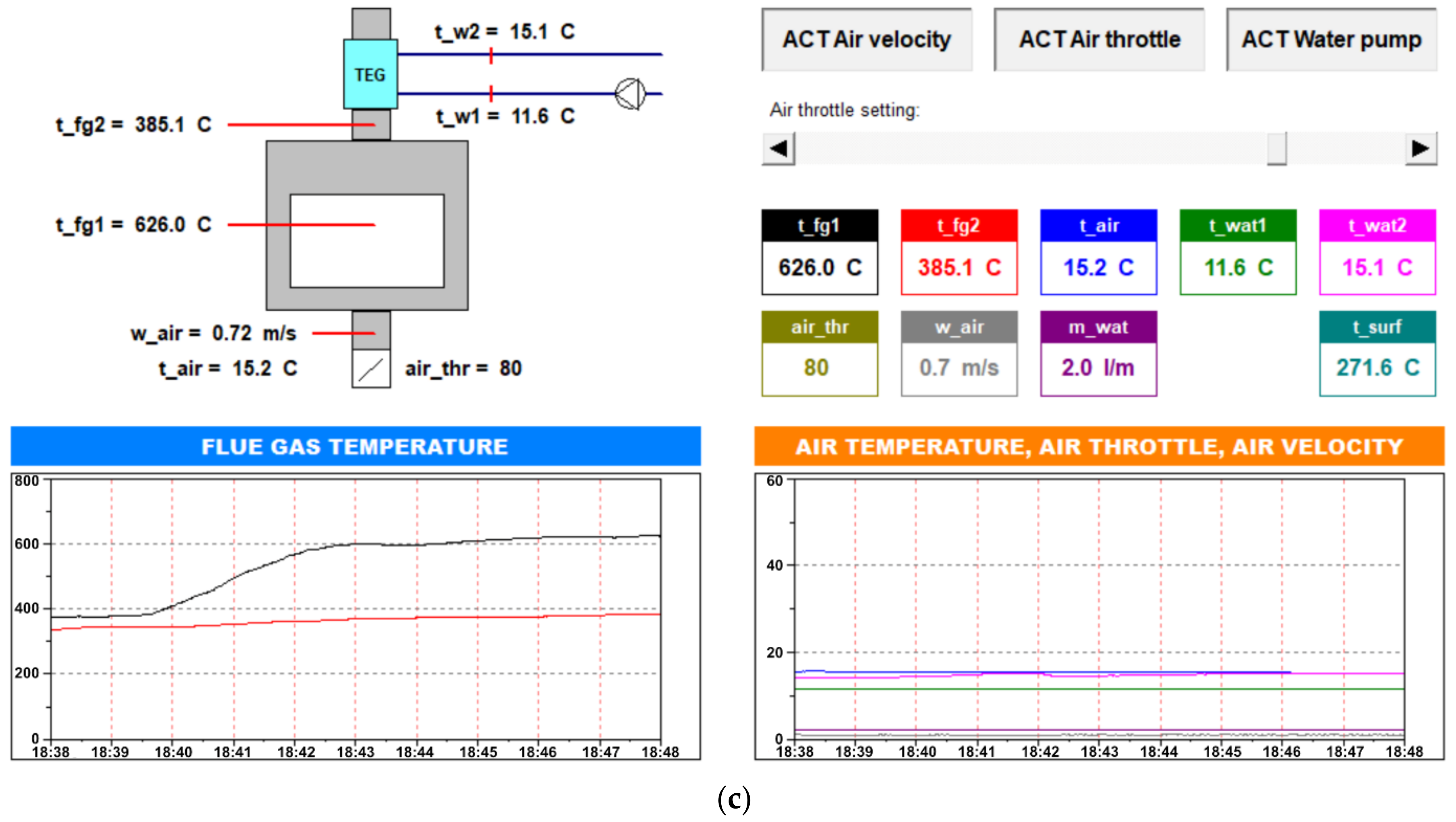
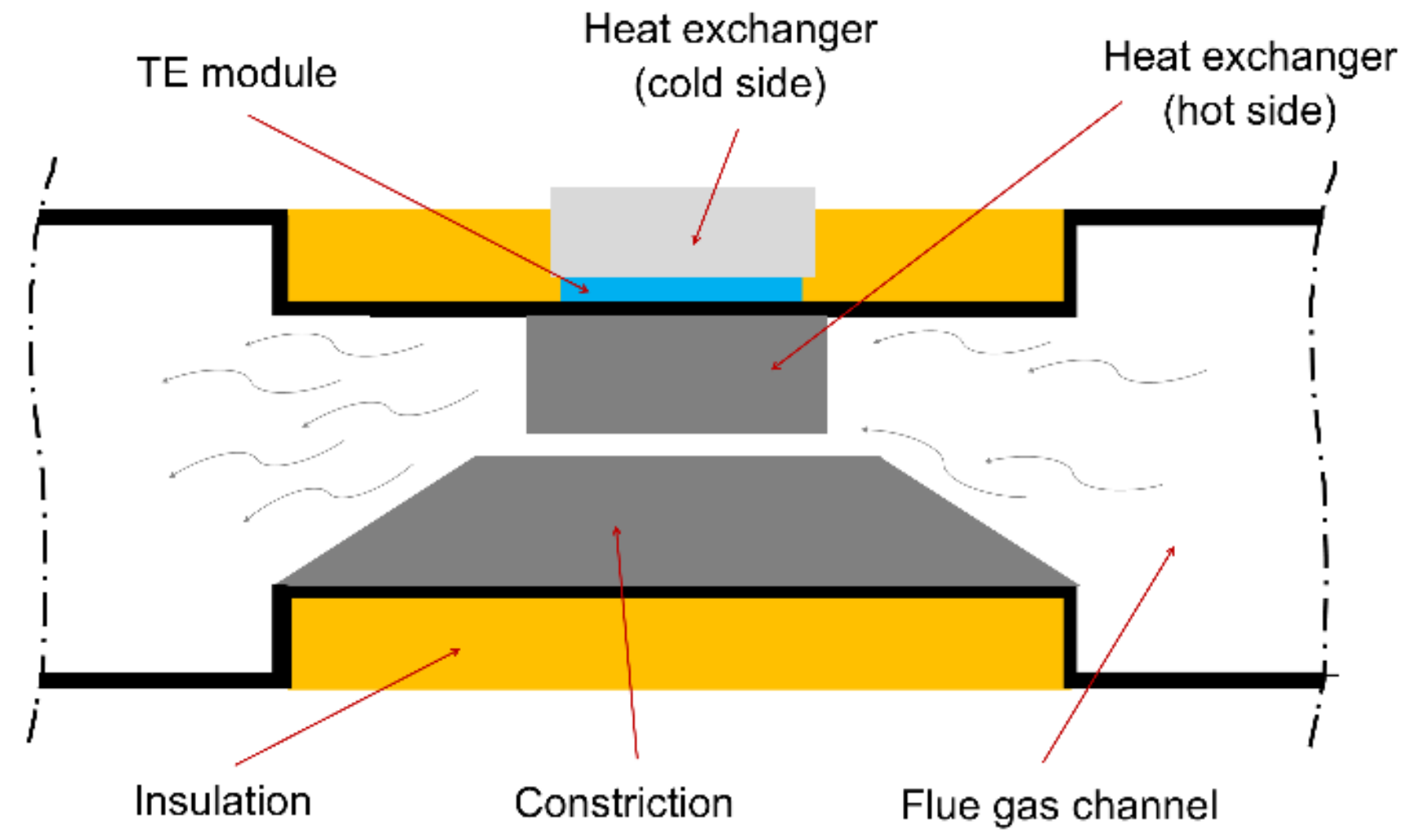
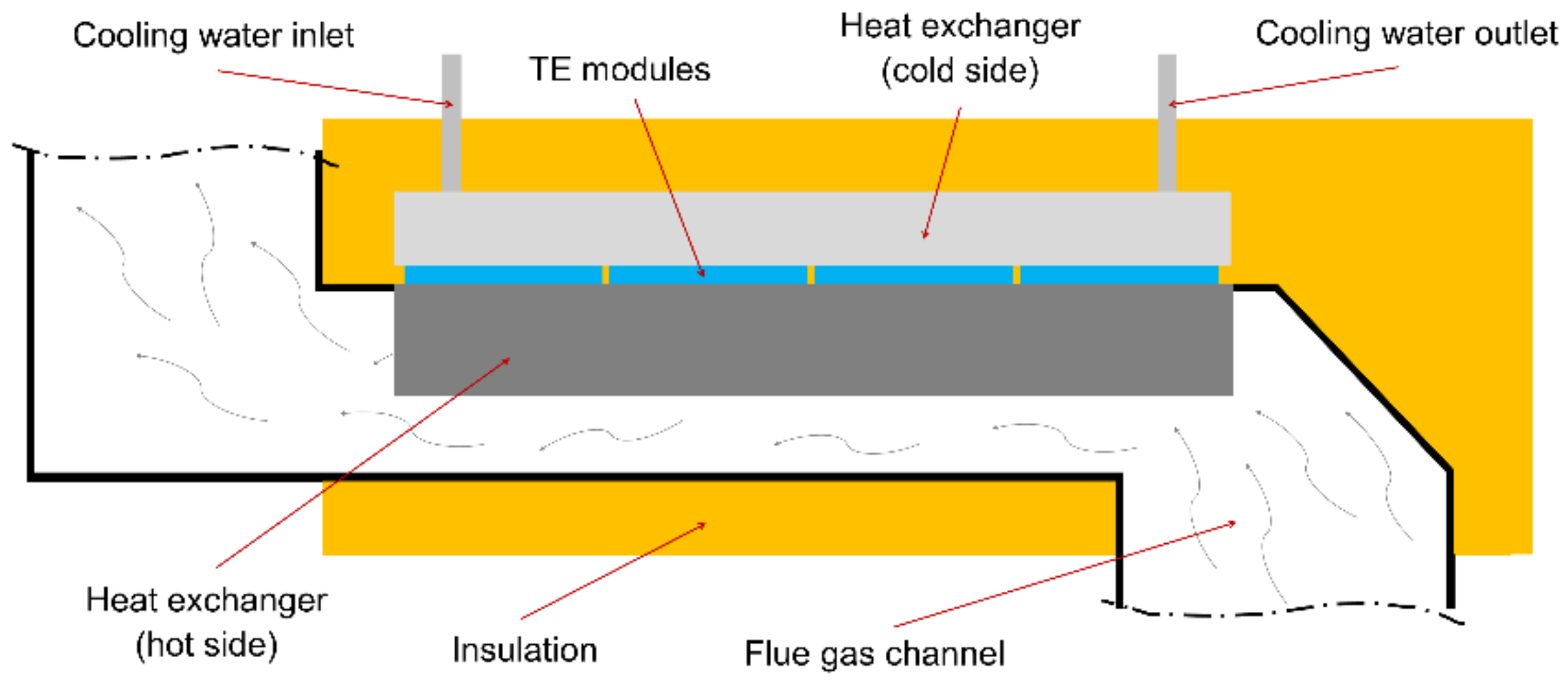

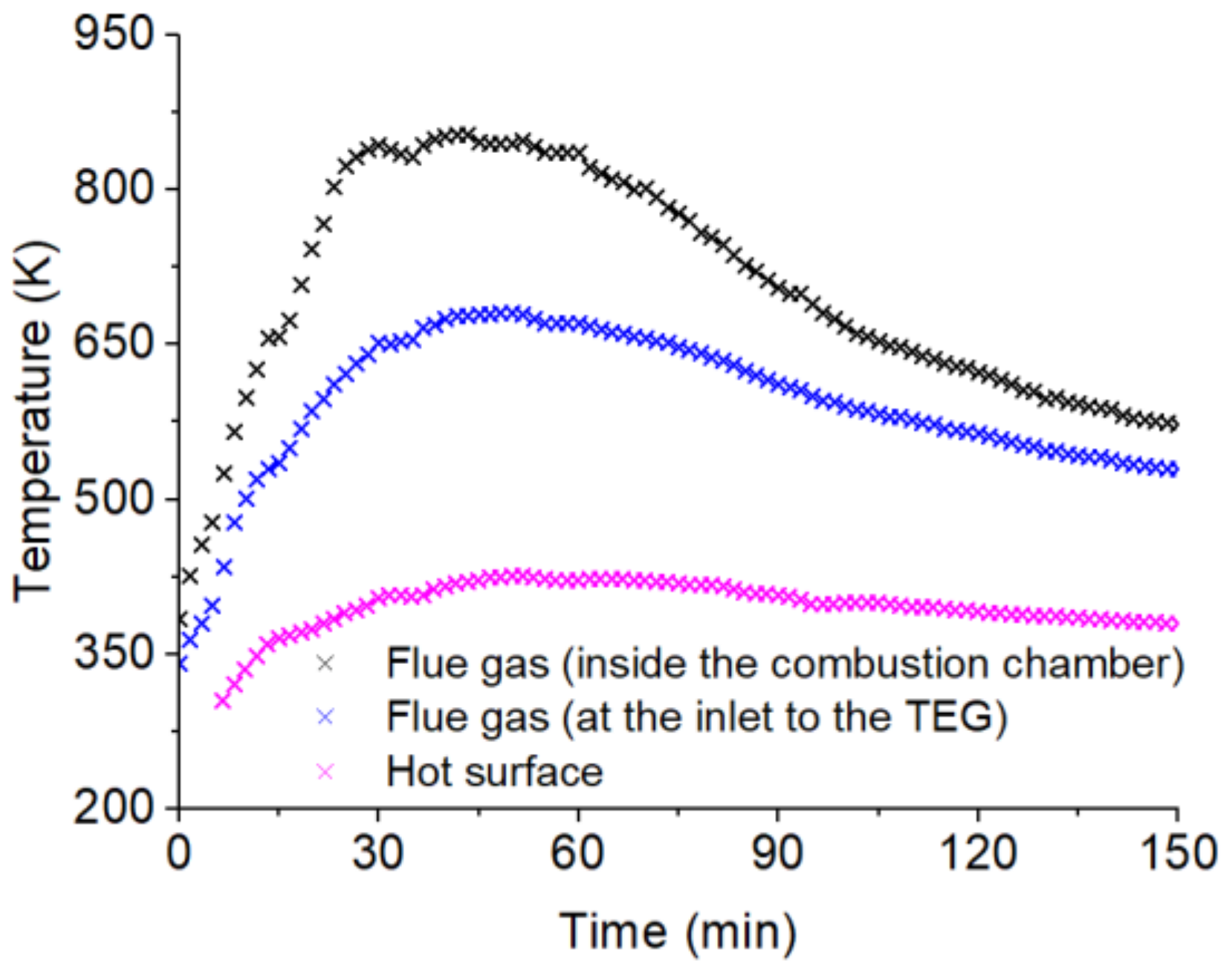

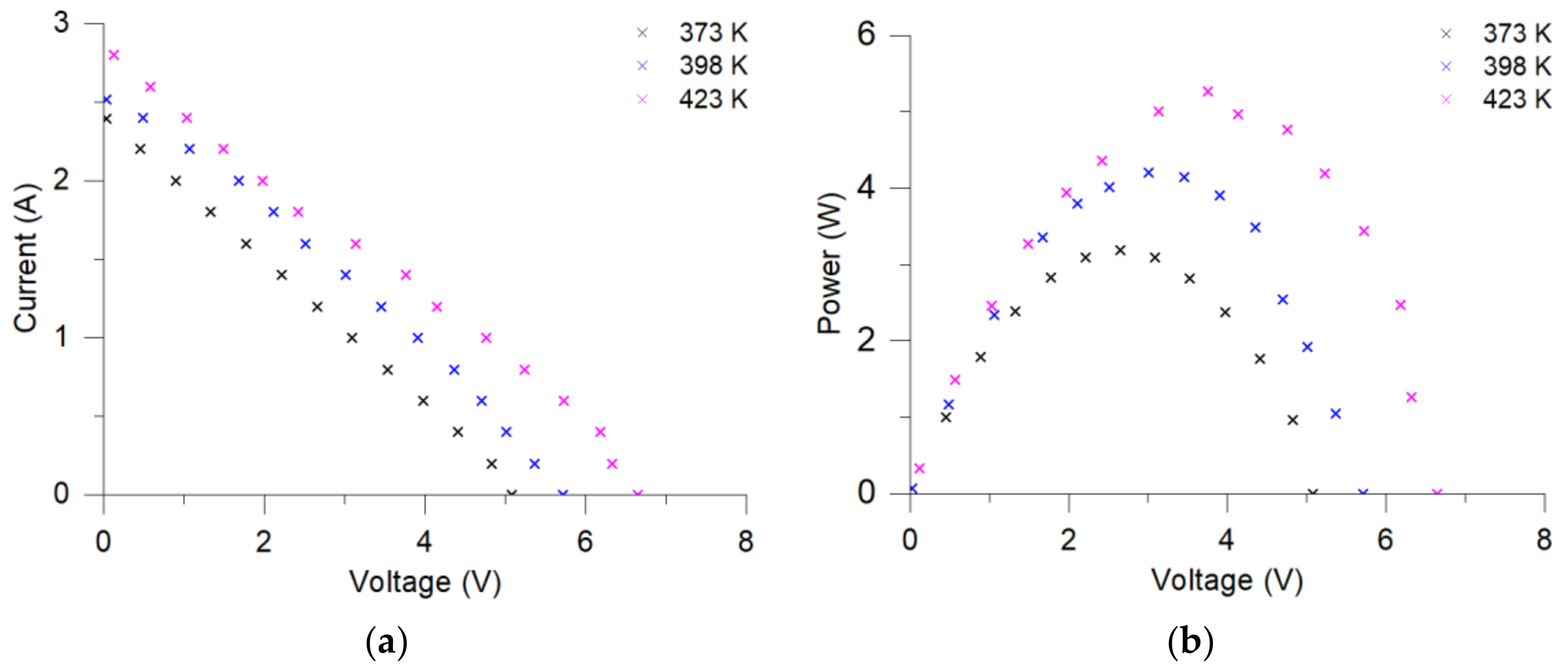

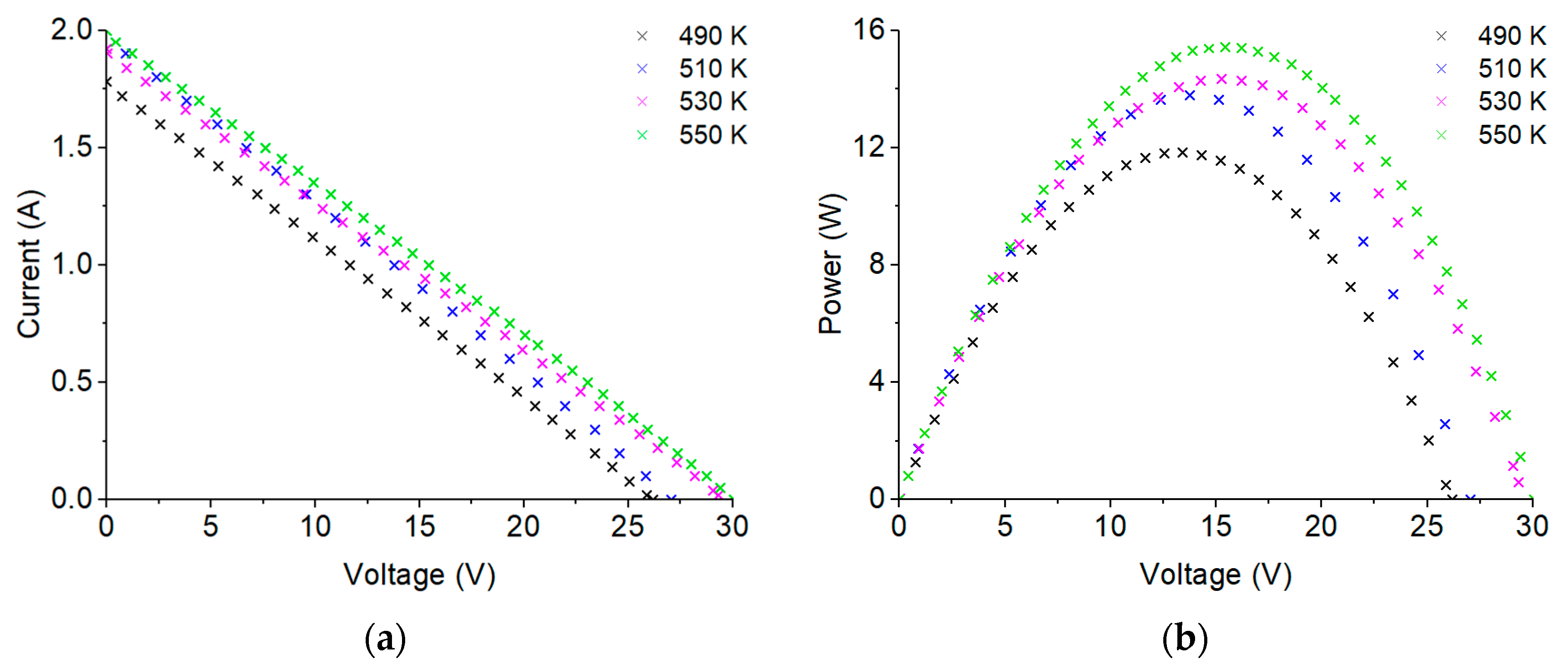


| Authors | Heat Source | Electrical Power, We | Application | Development Status |
|---|---|---|---|---|
| Lertsatitthanakorn [9] | Cooking stove | 2.4 | Battery charging | Laboratory tests |
| Mal et al. [14] | Cooking stove | 5.0 | Battery charging and lighting | Laboratory tests |
| Champier et al. [15] | Multifunction stove | 9.5 | Battery charging | Laboratory tests |
| Patowary and Baruah [17] | Cooking stove | 2.7 | Lighting | Laboratory tests |
| Lv et al. [18] | Portable gas stove | 12.9 | External load | Laboratory tests |
| Montecucco et al. [19] | Solid-fuel stove | 27.0 | Battery charging and power other equipment | Laboratory tests |
| O’Shaughnessy et al. [21] | Cooking stove | 5.9 | Battery charging and power other equipment | Field tests |
| Favarel et al. [22] | Multifunction stove | 28.0 | Power stove’s fan | Laboratory tests |
| Parameter | TEG No. 4 | TEG No. 5 |
|---|---|---|
| Matched power (given by manufacturer), W | 10.5 | 28.8 |
| Matched power (measured during tests), W | 5.3 | 15.4 |
| Matched voltage (measured during tests), V | 3.8 | 15.4 |
| Matched current (measured during tests), A | 1.4 | 1.0 |
| Flue gas temperature (when the matched power was measured), K | 423 | 550 |
| Comparative power coefficient (CPC), − | 0.51 | 0.54 |
| Comparative power to temperature coefficient (CPTC), W/K | 0.012 | 0.028 |
| TEG Parameter | Variant 1 | Variant 2 |
|---|---|---|
| Type of TE modules, − | low-cost | high-efficient |
| The number of TE modules, − | 16 | 16 |
| The matched power, We | 115.2 | 185.6 |
| The cooling medium, − | liquid (water) | liquid (water) |
| Temperature difference, K | 230 | 230 |
| Estimated cost, EUR | 350 | 500 |
| Parameter | Stand-Alone Unit | A Part of the Heating Installation | ||
|---|---|---|---|---|
| TEG—Variant 1 | TEG—Variant 2 | TEG—Variant 1 | TEG—Variant 2 | |
| Cost of the stove, EUR | 1250 | 1250 | 1250 | 1250 |
| Cost of the TEG, EUR | 350 | 500 | 350 | 500 |
| Assumed heat generation in the stove, kWhth/a | 10,500 | 10,500 | 6300 | 6300 |
| Assumed electricity generation in the TEG, kWhe/a | 94.2 | 151.8 | 56.6 | 91.1 |
| The annual saving in heating costs, EUR/a | 469.6 | 469.6 | 281.8 | 281.8 |
| The annual savings in electricity costs (including both energy self-consumed by the mCHP system and used by domestic appliances), EUR/a | 20.1 | 32.4 | 12.1 | 19.4 |
| SPBT (only installation of the stove), years | 2.7 | 2.7 | 4.4 | 4.4 |
| SPBT (only installation of the TEG to the existing stove), years | 17.4 | 15.4 | 28.9 | 25.8 |
| SPBT (installation of the mCHP system), years | 3.3 | 3.5 | 5.4 | 5.8 |
| NPV (only installation of the stove), − | 2376.1 | 2376.1 | 926.0 | 926.0 |
| NPV (only installation of the TEG on the existing stove), EUR | −194.8 | −249.8 | −256.6 | −350.2 |
| NPV (installation of the mCHP system), EUR | 2165.9 | 2126.3 | 669.4 | 575.8 |
Publisher’s Note: MDPI stays neutral with regard to jurisdictional claims in published maps and institutional affiliations. |
© 2021 by the author. Licensee MDPI, Basel, Switzerland. This article is an open access article distributed under the terms and conditions of the Creative Commons Attribution (CC BY) license (https://creativecommons.org/licenses/by/4.0/).
Share and Cite
Sornek, K. Study of Operation of the Thermoelectric Generators Dedicated to Wood-Fired Stoves. Energies 2021, 14, 6264. https://doi.org/10.3390/en14196264
Sornek K. Study of Operation of the Thermoelectric Generators Dedicated to Wood-Fired Stoves. Energies. 2021; 14(19):6264. https://doi.org/10.3390/en14196264
Chicago/Turabian StyleSornek, Krzysztof. 2021. "Study of Operation of the Thermoelectric Generators Dedicated to Wood-Fired Stoves" Energies 14, no. 19: 6264. https://doi.org/10.3390/en14196264
APA StyleSornek, K. (2021). Study of Operation of the Thermoelectric Generators Dedicated to Wood-Fired Stoves. Energies, 14(19), 6264. https://doi.org/10.3390/en14196264






